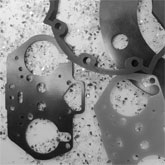Elastomere
Description

Elastomers are macro-molecular, organic substances with little cross-linked structure. As a result, they do not melt, are insoluble, partly subject to swelling and are elastic. Elastomers are based on rubber which is processed into various kinds of synthetic rubber, depending on the monomer. The various kinds of synchetic rubberdiffer slightlys in their properties so that they are used for different applications with regard to temperature, hardness, elasticity etc..
In addition to generally common mouldings such as Orings, our delivery range also includes customized mouldedarticles, profi le cords, punched or cut seals manufactured to specifi cations or to drawings, plates or rollers.
Preferred elastomer materials:
| Abbreviation | Usual trade designation | Base material |
|---|---|---|
| NBR | Perbunan®, Buna N® | Nitril-Butadien |
| EPDM | Buna A®, Nordel® | Butadien-Natrium |
| CR | Neopren®, Chloropren® | Chlor-Butadien |
| CSM | Hypalon® | chlorsulfoniertes PE |
| FPM | Viton®, Fluorel® | Fluor |
| VQM | Silopren® | Silikon |
| NR | Gummi vulkanisierter | Naturkautschuk |
| EPDM Qual. 0424 | – | – |
We alsoe process::
- Ceramic plates (ISOPLAN®,NEFALIT®)
- Asbestos-free fibreboard (AFP)
- Graphite material (GraFlex)
- Mica material
and fully synthetic plastics, such as:
- PTFE, filled / unfilled,
- PTFE TFM®,
- Polyurethane (PU),
- Polyethylene (PE)
- Polyvinyl chloride (PVC).
Most of the materials listed above are available ex stock from our extensivewarehouse. Materials in various thickness and versions regarding temperature and hardness are always available, so that we are able to deliver at short notice.
physical Data
| Elastomer | NR | NBR | EPDM | VMQ |
|---|---|---|---|---|
| Shore hardness °A | 40 - 90 | 40 - 90 | 50 - 80 (88) | approx. 60 |
| Temperature range °C | -50 to +70 | -30 to +120 | -40 to +120 | -60 to +200 |
| (230) | ||||
| Resistance to: | ||||
| Swelling in lubrication oil | low | very good | low/average | average |
| Mineral oil + fuel | low | excellent | low | average |
| Animal + vegetable fat | low/good | very good | good | good/excellent |
| Water absorption | very good | good | very good/excel. | excellent |
| Sunlight, weather | good | low | outstanding | excellent |
| Water vapour <150 °C | not suitable | not suitable | very good | |
| Water vapour >150 °C | not suitable | not suitable | good | |
| Abrasion | good | good | good | average |
| Expansion, tensile strength | excellent | good | good | good |
| Elasticity | excellent | average | good | good |
| Elastomer | FKM | CR | Kalrez® | Chemraz® |
|---|---|---|---|---|
| Shore hardness °A | ~75 | 40 - 90 | ~80 | ~75 |
| Temperature range °C | -20 to +200 | -40 to +80 | -50 to +315 | -30 to +230 |
| (230) | (100) | (350) | (260) | |
| Resistance to: | ||||
| Swelling in lubrication oil | excellent | average | excellent | excellent |
| Mineral oil + fuel | excellent | good | excellent | excellent |
| Animal + vegetable fat | excellent | good | excellent | excellent |
| Water absorption | very good | good | very good | very good |
| Sunlight, Weather | outstanding | very good | outstanding | outstanding |
| Water vapour <150 °C | not suitable | conditionally | good | good |
| Water vapour >150 °C | not suitable | not suitable | good | good |
| Abrasion | average | very good | good | good |
| Expansion, tensile strengthvery | verage | average goodvery | averagevery | average |
| Elasticityvery | goodvery | goodvery | goodvery | good |
The data listed above provide initial orientation. Due to the variety of different mixtures, the list only gives approximate values which serve as a rough guide. Please note that the foregoing data cannot form the basis for damages claims.